The following information is prepared for the novice hickory player who requires general guidelines for building his/her first set of hickory clubs. It was originally written by Richard Grula and has been refined and edited by Jim Davis. It assumes the reader has a basic or introductory experience with hickory golf. One bit of good advice that never fails is to contact a more experienced player in your area or one from the list of equipment dealers and contacts listed on this web site. check the Resources for Regional Play Groups and find one nearest you.
For information on the Society’s Hickory Golf Equipment Guidelines, please click here.
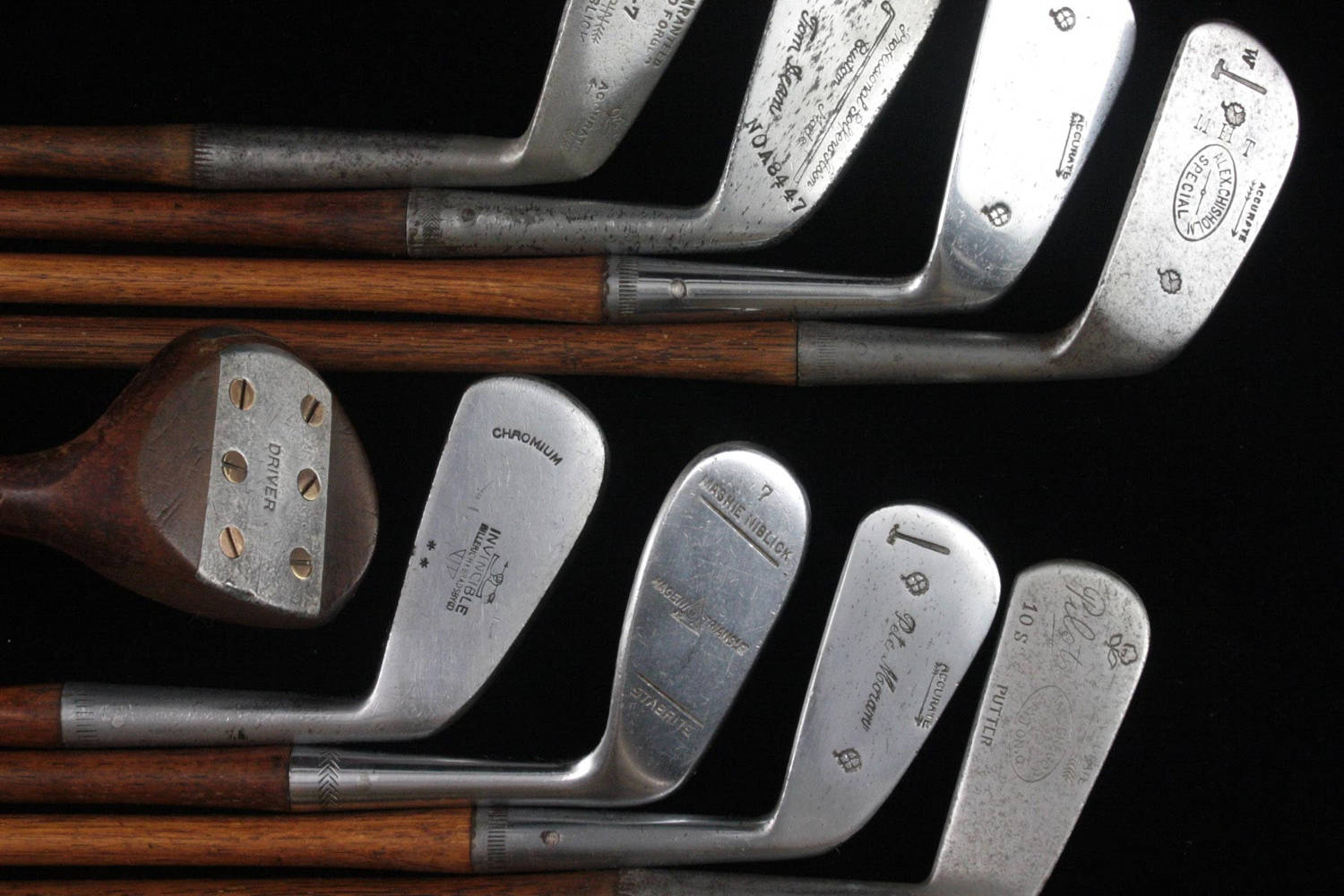
“In those happy, far-off times the collecting of a pack of clubs was the work of years; one had been picked up here and one there, and every club had its own history; a shaft was a living thing with an individuality of its own, and when it died it left a gap in society.”
Bernard Darwin
A Fresh Start (Playing the Like, 1934)
IT STARTS HERE
You’ve got the fever. Maybe you entered a hickory golf tournament and fell in love with a rented a set of wood-shafted clubs. Or maybe a friend lent you a set of hickories for a nine-hole exploration of golf tradition. Whatever the lead-in, your interest was piqued and now you’re at the SoHG website asking the same question that every modern hickory player has asked – how do I put together my own set of hickory clubs?
We’re here to help.
In the short term, your goal is to assemble a hickory “play set.” Remember, that phrase “play set” is key. You’re going to play golf with these clubs. You need clubs that can take to the course and hit. You don’t want super expensive collectables that are too valuable to swing and you don’t want cheap, unplayable “wall hangers” that produce nothing but frustration on the course. A decent play set is the essential starting point to transforming your relationship to hickory golf into something more permanent.
THE BASIC SET
Although the modern set of golf clubs typically numbers 14, a basic hickory set has fewer clubs. The late Ralph Livingston III, one of the pioneers of modern hickory golf, recommended a six-club collection as a basic starter play set. This is what you’ll see in many rental hickory sets too.
- Brassie – serves as both a driver and fairway wood, about 13-14 degrees loft
- Mid-Iron – for long iron shots, about 25-27 degrees loft
- Mashie – for approach shots, about 34-36 degrees loft
- Mashie Niblick – short approach and pitch shots, about 43-47 degrees loft)
- Niblick – lofted for bunker and pitch shots, 52 -57 degrees loft
- Putter – for putting and maybe defending yourself
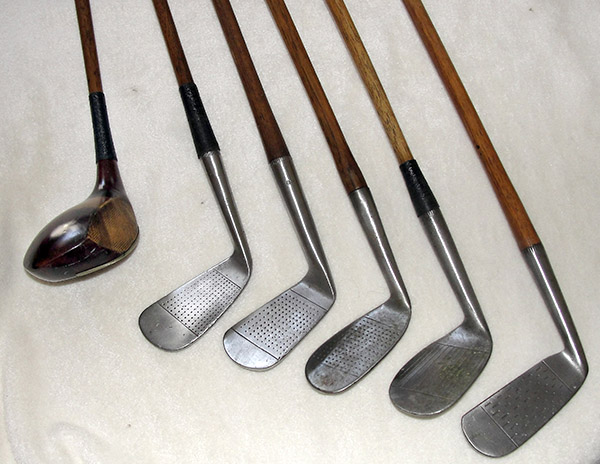
The basic six-club hickory play set.
There are many more kinds of hickory clubs than what’s listed above. As you get further into the game, you’ll probably fill out your set with a jigger or Benny or maybe a bulldog and cleek. You might even pick up multiple niblicks, seeking the one that feels perfect in your hands. You’ll also discover where there are loft gaps in the ranges of your clubs and look to fill those. All well and good. But for the moment, keep things simple and target a basic set.
FOR THE LADIES
The same rules apply when searching for clubs for the fair sex. Many club makers of the day built slightly lighter, slightly shorter clubs for women players. Often, these clubs are stamped with an “L” on the back of the club head. Be that as it may, it’s not necessary to expend all your energy and time to find L-marked clubs. Follow the overall general guidelines laid out to here to select clubs that feel right to you and suit your swing.
MIS-MATCHED?
Look carefully at the set pictured above and you’ll notice the faces of all the irons are different. There are grooves, dots, lines and various combinations. That’s because they come from different manufacturers and that’s just fine. Just as back in hickory’s heyday, it is normal for a play set to be assembled from different manufacturer’s clubs. What’s important is to find clubs that work for you and your swing. Matched sets exist, but they are scarce and usually priced at a premium. Save that quest for later.
By the way – all the clubs shown above are known as commons. When hickory golf was at its peak, literally millions of clubs were produced. Many have survived to this day and those mass-marketed items not considered collectable or particularly desirable by modern players are often lumped into the category called “commons.” Some of these are clunky, chrome-plated garbage, but many are very playable and quite inexpensive (think under $20 per iron), though they usually need a little restoration to be fully playable. Don’t let the unflattering nature of the word common bother you. Every hickory player has a few favorite clubs that are both common and fabulous.
ORIGINALS OR REPRODUCTIONS?
Now that you know what you’re looking for, you have a choice. You can spend the time and effort it takes to seek out original, pre-1935 hickory clubs or you can purchase ready-to-go reproductions.
There are three modern makers of hickory clubs whose products are approved for play by the Society of Hickory Golfers:
- Louisville Golf (www.louisvillegolf.com)
- Tad Moore (www.tadmoore.com)
- St. Andrews Golf (www.standrewsgolfco.com)
Each produce replica hickory clubs whose designs are based on authentic clubs produced in the pre-1935 hickory era. They hold their craft to a high standard, turning out first-class products that are beautiful and very playable. Many modern hickory golfers who lack the desire or time to search for and rehabilitate old equipment embrace reproduction hickory sets and such clubs are legal for play at SoHG-sanctioned events.
For others, a large part of the allure of hickory golf is the ongoing search for original, playable clubs. It is this hunt, the discovery, the trading and negotiating with other players, and the testing of each new acquisition out on the course that forms part of the backdrop of the modern hickory game. If this sounds interesting, there are a few avenues to acquire original hickory clubs. Let’s consider the advantages and disadvantages of each buying situation.
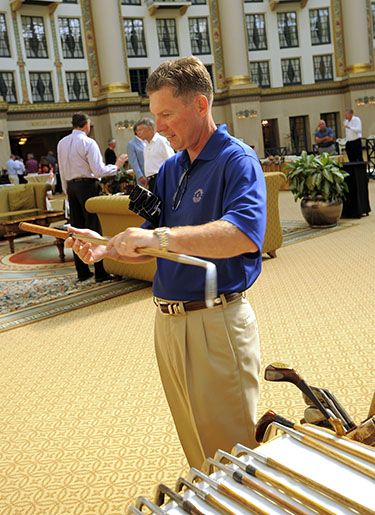
Examining a club in person is perhaps the best way to purchase a playable hickory club.
PERSON-TO-PERSON
For many, this is the ideal way to acquire hickory clubs –from a friend, at a tournament’s trade/swap meet, a Golf Collectors Society meeting or the rare shop that carries hickory clubs. The benefits are many. Ideally, the seller is knowledgeable and can answer questions. Such clubs have often been tested and restored (or at least cleaned up to some degree) so they can be put directly in your bag and played. In the best situation, the seller might let the buyer take the club to the range and hit a few balls before cash is exchanged (a lot of club sales happen at the ranges of hickory events).
If there’s a downside, it’s usually price – clubs purchased this way are often priced closer to their premium because a knowledgeable seller tends to know what a club is worth. For many people, it’s no problem to pay a bit of a premium to get a good quality club that’s been vetted by a knowledgeable player and hopefully restored for play.
Plus, the option to negotiate is always there, so strike your best deal.
One note – occasionally, a non-playing collector might be selling clubs he’s never hit or vetted in the least. He might have bought commons at an estate sale, increased the tag price and thrown them on a table at a show, hoping to make a quick few bucks. While it is possible to find a gem in such a situation (especially if you know exactly what you’re looking for), experience has shown such clubs are often priced too high for the degree of uncertainty involved.
NON-GOLF VENDORS
Antique shops, flea markets and thrift stores – stores without any serious link to golf often become the outlets of first resort for hickory clubs. Upon someone’s death, for example, the attic is cleaned out and that old bag of hickories makes its way to a shop where the sellers know nothing about golf. Often, these people only consider hickories for their decorative possibilities (where do you think those bars and pro shops get the wooden clubs hanging on their walls?).
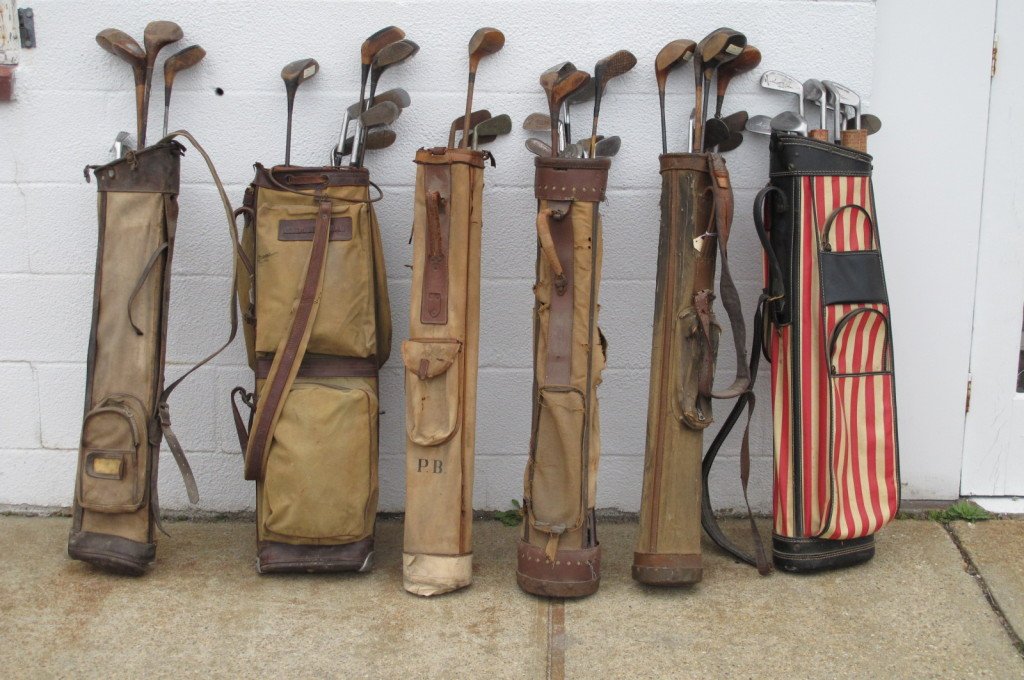
A pile of old clubs and bags for your purchasing pleasure.
Occasionally, deals can be found in these situations – particularly since the sellers can’t believe anyone would actually swing these clubs. More likely, the clubs will be overpriced and abused in some way (sloppily painted, for instance). Antique dealers who know little about golf are likely arriving at their prices via any number of methods, including antique catalog guides that usually do not reflect current values, so don’t be surprised if you see hickories in such shops marked as much as $75 or $100. It’s a rare club that is worth this amount, so don’t be fooled. Ask the dealer how he arrived at his price. Considering the amount of restoration typically needed, a flea market club is rarely worth $20 – $5 is probably closer to the real value; unless you know for a fact you are looking at something truly special.
EBAY
Nearly every hickory player will tell you horror stories about blindly buying clubs on eBay. There are cut-down irons, drivers with cracked shafts, sellers who lie in the description or never ship the club. Yet, almost every hickory player buys clubs on eBay. Why? Because despite the occasional bad club and the rare evil seller, hundreds of hickories are bought and sold on eBay monthly and most transactions are satisfactory. There is a huge, ever-changing inventory of hickory clubs on eBay and if you’re smart and patient, you can get some great deals.
The primary downside of eBay is you don’t have the club in your hands to inspect. You’re relying on pictures (often blurry) and descriptions (often maddeningly vague) created by people who often don’t know anything about the club they’re selling. Of course, when a seller doesn’t know what he has, tremendous deals for the buyer are possible. Even so, caution is essential. While there are entire books devoted to buying and selling on eBay, below are some eBay-specific tips for hickory club purchases.
- Hickory clubs on eBay are usually found in the Sporting Goods / Golf / Vintage section. If you want to eliminate all the steel shafted clubs, search that section for “hickory” (Title & Description). Be aware, such a search will also eliminate those listings where the seller used the phrase “Wood-shafted club!” Those listings can be the greatest bargains, because nobody’s looking at them.
- If you’re going to be actively buying and selling on eBay, a PayPal account is essential.
- As of this writing, standard starting price for common hickory irons is around $9.99. People offering “Buy It Now” deals of $49 and $79 for common irons are looking for suckers.
- Depending on current demand, final prices for those $9.99 commons usually range from $9.99 to just under $30.
- Particularly desired items –Tom Stewart and George Nicoll clubs, Bakspin irons, matching sets – will go for much more.
- Shipping typically is $9 to $13 a club. A seller should offer a shipping discount when multiple items are purchased and shipped together.
- Sunday evening seems to be the busiest time for hickory auctions, both in terms of number of items being sold and number of buyers online actively bidding.
- Considering the above, if you find a great item with a Tuesday morning end date, pay close attention because you might be the only bidder at the close of the auction.
- Swingweight (see below), a measure of a club’s weight, is a consideration, because many hickories have very low, or light, swingweights. Look for sellers who note swingweight and if they don’t, ask via e-mail (sadly, many sellers won’t know).
- Always note the shaft length. A regular niblick should be about 36 inches long. If an eBay listing says a niblick is 33 inches, you’re dealing with a cutdown, or a club made for a woman or child. If it is not listed, ask for a measurement.
- Try to figure out how straight the shaft is by using straight lines in the picture (like a carpet or tile edge) to judge any apparent degree of warp. Avoid warped shafts unless you love the head and are ready to reshaft it.
-
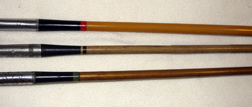
Pyratone shafts are steel sheathed in a plastic-like substance called pyratone. Common in the late 1920s-30s.
Learn the difference between hickory and pyratone faux-wood shafts. Pyratone was a non-metallic casing patented in 1926 and used to coat early steel shafts. The material was mostly yellow, black and brown and made to resemble wood. Unknowledgeable sell ers often sell pyratone shafts as hickory. Unsure? Try a magnet. This will stick to the steel shaft beneath the pyratone sheath. Also, note the joint between the shaft and the head. Pyratone shafts have a little ferrule that joins the shaft to the head. On a hickory iron, the shaft goes directly into the head, where it’s glued and pinned. Pyratone clubs are not legal for SoHG play.
- A complete lack of pictures (or only one blurry one) in an eBay listing is a good sign to avoid that auction.
- Read the seller feedback to discover with whom you’re dealing. A solid reputation is prized on eBay and the products from such sellers can usually be relied upon (plus, they can provide more info when you request it). Often, they sell a lot of hickory clubs, so you might wish to mark such sellers as a “Favorite”.
- Since these clubs are 80+ years old, the original glues have often decayed and some looseness should be expected. Regardless of claims of tight fits, expect to reattach the head of iron with modern epoxy. Some hickory club restorers do this routinely with new acquisitions. You might also have to fix the whippings, regrip the club and apply a few coats of varnish to the shaft. These are minor issues and most hickory players acquire these skills quickly.
TIPS FOR EXAMINING CLUBS
These very basic tips are designed to help you find some strong, playable starter clubs. As you begin to develop a feel for the game and know what you like, you will want to learn more. Visit the Resources page on this website for further reading, additional websites to explore and for names of hickory mentors in your area who can help you learn more about club selection.
Irons
Look for clean, non-rusted metal. Forged irons, particularly from Scotland, are desirable. Older irons used softer metals. Irons marked “rustless” are usually of a stainless steel and have a “harder” feel to them, but then these are easier to keep clean. Best to avoid chromed club heads. Many hickory era irons have very little degree of “bounce” – the backward angling of the sole – hence they tend to dig sharply into the ground. So, be sure to check this angle by holding the club in front of your eyes and checking from toe to heel. The loft angle can often be adjusted by those who have experience and the proper tools. Check Resources for names of repair and restoration individuals.
Deep, clear stampings are desired as there is a lot of information to be found on the back of a hickory iron – type of club, clubmaker, selling company or professional, player. At the very least, learn about cleekmarks and what they mean. Peter Georgiady’s book, Collecting Antique Golf Clubs (Airlie Hall Press), is an excellent guide.
The Shaft
Is it dried out or cracked? A dry, brittle shaft will be susceptible to cracking. Is the finish still sound? Any blotchy areas may indicate water damage. Is the shaft straight? Does the grain run the length of the wood? Look at the butt end. Can you count the growth rings? Seven is average. More is better and signifies a strong shaft. A slight bend up or down is often no problem (these are sometimes called a “Carnoustie” or “St. Andrews” bend, depending on the direction). Fixing a slightly warped shaft is possible, as is replacing a shaft entirely, but these are projects that require skill or money. Severe warping is to be avoided.
Swingweight
Many original hickory clubs have a bantam swingweight like A8 (particularly true in hickory drivers). Randy Jensen (classicgolf@hotmail.com), one of the best hickory players of this age, recommends a swing weight of between C3 and D7. Weight can be added to irons and woods (this is easier with woods), but it is best to find original hickories with a playable swingweight.
Wood Heads
Don’t worry about the smaller headed hickory drivers. The average depth of a hickory face driver from this time is about 1 3/8-inches. These play just fine once you make the mental adjustment from the behemoth modern variety. Deeper faces can sometimes be found, just be sure the weight suits you. Remember, weight can always be added to wood club heads. As for fairway woods – brassies, spoons, bulldogs – make sure these have a decent lie angle. For shorter players, a 52 or 53 degree angle is great. For taller players, look for fairway woods in the 58-62 degree range.
Putter
Many putters of the hickory era have a higher degree of loft – some putting cleeks are around 10-12 degrees. Most are around 7 degrees and quite light, but there are mallet styles that are heavier. There is a wide variety out there. Pick them up. Practice a few strokes. Heavier is probably better that lighter. Note how the putter feels, try a dozen or more, then buy the one you like.
Get out to the course
Assembling a play set is an ongoing process – remember Bernard Darwin’s quote above? The play set you put together tomorrow will change constantly as you discover/trade for/acquire different clubs that fill in gaps in your set or provide a better feel or enhanced playing experience. Buying, trading, selling – it’s all part of the hickory game. The most important advice is to have patience, solicit counsel from experienced players and, above all, enjoy the journey. The sensation of hitting a ball on the sweet spot of a hickory club that you have put in the time and the effort to locate and prepare for the course is a uniquely satisfying experience, unlike any other in golf.
To find a mentor in your area who can help you get started on your hickory set:
- Check out one of the local playing groups. Many if not all of these groups have members who are well versed in hickory club restoration.
- Contact the current SoHG Secretary Scott Staudacher or SoHG Executive Director Jim Davis for help in locating such a person.
Sources for vetted, playable beginner sets of original clubs
We will add to this list as new sources ask to be listed here.
- The Wyandotte Hickory Organization, in Wyandotte, Mich., south of Detroit, has made a group activity of assembling good playable sets of original clubs. Bill Ellington (bellington1@live.com) and Bruce Markwardt (bmarkwar@comcast.net) of the Wyandotte group are contacts for this source. You may contact them for questions and to arrange for purchase and shipping. (The SoHG does not guarantee the quality of these or any clubs from private sources, nor can it act as an arbiter in any dispute.)
Excellent books for the beginning hickory golfer
Collecting Antique Golf Clubs, by Peter Georgiady, Airlie Hall Press, (Third Edition, 2013)
Wood Shafted Golf Club Value Guide, by Peter Georgiady, Airlie Hall Press, (Eighth Edition, 2013)
Also, if you look for value guides and books, you will see editions from various authors. Early large paperback volumes from John and Morton Olman, and Chuck Furjanic are among the best.
